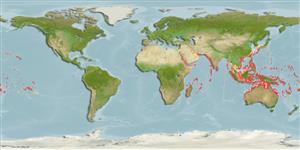Common names from other countries
Environment: milieu / climate zone / depth range / distribution range
Sinh thái học
Biển Cùng sống ở rạn san hô; Mức độ sâu 0 - 40 m (Ref. 9813), usually 1 - 30 m (Ref. 27115). Tropical; 25°C - 29°C (Ref. 27115); 30°N - 30°S, 32°E - 128°W
Indo-Pacific: Red Sea and East Africa to Pitcairn. Often the only siganid present on remote islands like Pitcairn, Rapa and Line.
Length at first maturity / Bộ gần gũi / Khối lượng (Trọng lượng) / Age
Maturity: Lm ?, range 20 - ? cm
Max length : 40.0 cm TL con đực/không giới tính; (Ref. 9813); common length : 25.0 cm TL con đực/không giới tính; (Ref. 9813)
Các tia vây lưng cứng (tổng cộng) : 13; Các vây lưng mềm (tổng cộng) : 10; Tia cứng vây hậu môn: 7; Tia mềm vây hậu môn: 9; Động vật có xương sống: 13. This species is distinguished by the following characters: juveniles and adults with body oval and compressed, slender, fusiform, greatest body depth 2.4-3 in SL; anterior nostril with a long flap reaching to or past posterior nostril; last dorsal-fin spine very short, 2.6-3.5 times in longest dorsal-fin spine; last anal-fin spine shortest, 2.1-3.1 times in longest (second or third) anal-fin spine; caudal fin deeply forked. Colour of body blue or greyish above, silvery below; variations in markings (spots, curved lines); head and trunk usually covered with small yellow spots, bars, and commas, much larger than interspaces and quarter to 1/2 size of pupil; spots usually joining to form horizontal wavy lines, particularly on lower sides; yellow pectoral-fin axil, usually yellow stripes along base of dorsal fin and a dark brown bar immediately posterior to the upper opercular margin; colours fade rapidly at death so that head and trunk may be solid brown (Ref. 9813, 90102).
Inhabits coastal and inner reef slopes and lagoons. Usually occurs in large schools that swim fast and well above the substrate, occasionally all diving down to the bottom to feed (Ref. 48637). Juveniles and adults occur in small schools (2-100) around coral reefs, typically in surge zone at reef edge. Juveniles live near the surface in dense aggregations up to several km offshore, migrating to reef flats just prior to metamorphosis. Feeds on algae (Ref. 30573). Juveniles and adults not frequently found in markets; but prejuveniles form a brief but important fishery when migrating on to the reef flat, e.g. combined catch (with Siganus spinus of 16 tonnes in one season in Guam. Prejuveniles eaten fresh, pickled in brine or made into fish paste (Ref. 9813). Consumed as food although it is known to be occasionally poisonous (Ref. 4537). Used in Chinese medicine (Ref. 12166).
Spawn in group (Ref. 240).
Woodland, D.J., 1990. Revision of the fish family Siganidae with descriptions of two new species and comments on distribution and biology. Indo-Pac. Fish. (19):136 p. (Ref. 1419)
IUCN Red List Status (Ref. 130435)
CITES (Ref. 128078)
Not Evaluated
Human uses
Các nghề cá: Tính thương mại; Bể nuôi cá: Tính thương mại
Các công cụ
Special reports
Download XML
Các nguồn internet
Estimates based on models
Preferred temperature (Ref.
115969): 24.6 - 29, mean 27.8 (based on 1374 cells).
Phylogenetic diversity index (Ref.
82804): PD
50 = 0.5000 [Uniqueness, from 0.5 = low to 2.0 = high].
Bayesian length-weight: a=0.01413 (0.01133 - 0.01761), b=2.99 (2.94 - 3.04), in cm Total Length, based on LWR estimates for this species (Ref.
93245).
Mức dinh dưỡng (Ref.
69278): 2.0 ±0.0 se; based on diet studies.
Thích nghi nhanh (Ref.
120179): Chiêù cao, thời gian nhân đôi của chủng quần tối thiểu là dưới 15 tháng (K=0.75; tm=1).
Fishing Vulnerability (Ref.
59153): Low vulnerability (22 of 100).
